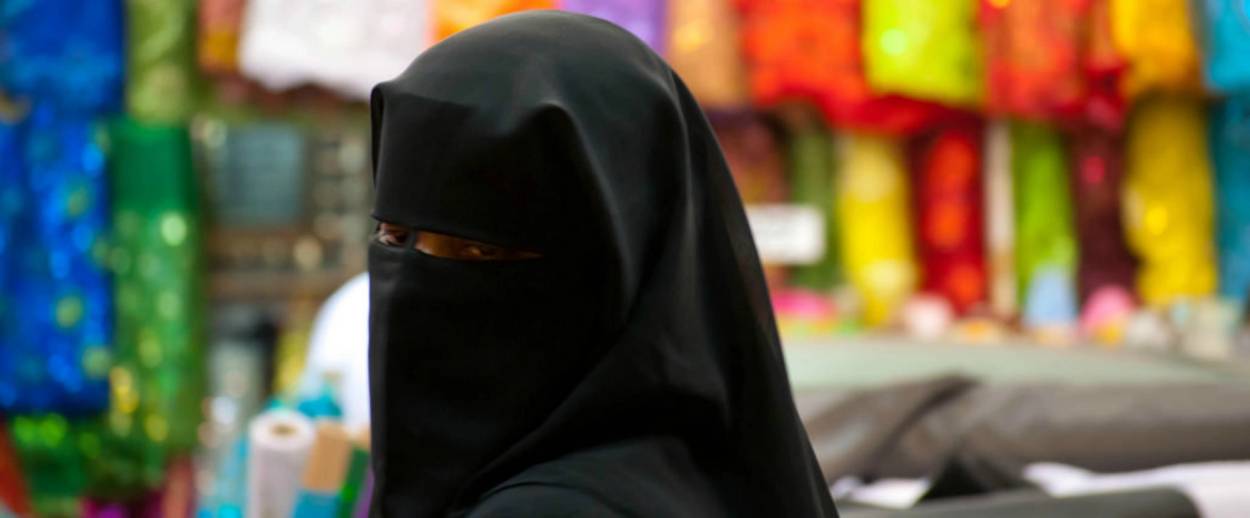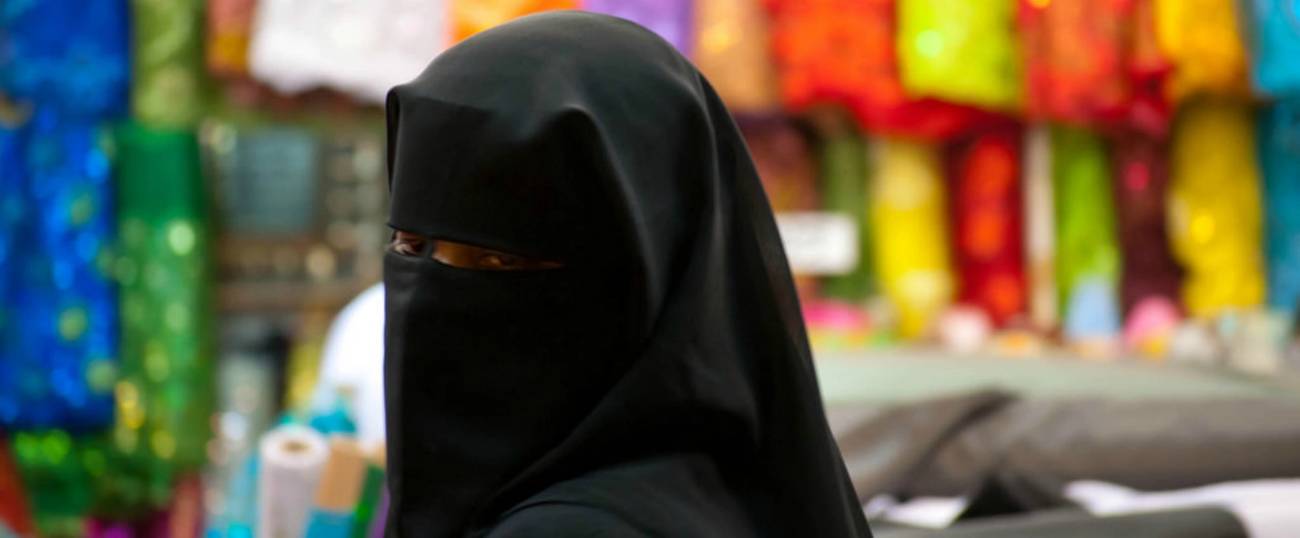How Do You Acknowledge a Woman You Can’t See?
A response to Elham Manea on ‘Judith Butler’s Veil’




When I first joined my Orthodox synagogue 14 years ago, I used to wear a kippah, just as I did in my former Conservative synagogue. However, I’ve been wearing a hat for many years now, but not because I believe it is religiously mandated; rather, it is because other women wear hats or pin lacy mantilla-like head coverings to their hair. Otherwise, they are naked-faced. I can recognize each one and greet her. Since these are modern Orthodox congregants, (the women are doctors, lawyers, investment bankers, psychotherapists, caterers, social workers, etc.) most do not wear head coverings in their daily lives.
Nor do I. I have no need to set myself apart in the public square, no need to identify myself in terms of my ethnicity or religion. My words and deeds will speak for me “in the gates.”
But I do understand the pull of wanting to respect the customs of a chosen or inherited group. Thus, I have no problem with head coverings per se. A Sikh’s turbans, a nun’s habit, the South Asian Muslim head-covering for men called a taqiayah, and hijab (headscarves or head covering) for Muslim women are just fine because they do not obscure identity.
However, even in terms of hijab, at least as far as I’m concerned, there is a huge difference between a colorful, fashionable, headscarf which by its very nature signals “friendliness,” and a dark, heavy, head covering which covers the shoulders and bosom—and which is somewhat off-putting, forbidding—at least it is to someone who does not “cover.”
I feel the same way about the “uglification” of certain ultra-Orthodox Jewish women who wear large, long, shapeless dresses, dark stockings, big, bulky coats, and farbissene headgear. And so now, let us contemplate the head, face, and body coverings worn by Muslim women.
I happily worked with Elham Manea at a G-8 conference in Rome some years back. We were a tight group which included a Turkish woman who lives in Germany; an Iraqi woman who lives in America; Elham, a Yemeni woman who lives in Switzerland; a Saudi journalist who lives in the kingdom and who was “minded” by her 16-year-old son; and several women from Afghanistan. I do not want to quarrel with Manea but I do wish to engage her in a civil dialogue about her piece “Judith Butler’s Veil.”
I hope this does not make me an “Orientalist” or an “essentialist.” These are two straw women whom Manea sets up only to knock down. But we’re not entirely sure what their sins really are (beyond being Western or infidel) or wherein lies the road to salvation.
Manea’s piece is smart, dense, obscure, academic, which is typical of all postmodern academic writing. I believe this is because such academics do not want non-Mandarins to understand what they are saying and, for that matter, do not want to be held liable for what they are saying. This is entirely my own view. They might easily defend it as following the required customs of their professors, journal editors, and all those upon whom they depend for funding and tenure. (See my opening paragraph.)
Still, upon reading Manea’s piece, one does not know—perhaps one is not meant to know—where she herself stands on this issue. But why not? Does she believe that a niqab (a face veil) or a burqa (a total body bag), is a free choice or a forced choice—and depending on which one it is, what the formerly colonized Muslim state or the former colonizing Western state are supposed to do about it, if anything?
In 2011, Algerian-American professor Marnia Lazreg wrote an elegant little book titled Questioning the Veil: Open Letters to Muslim Women. She implores Muslim women not to veil, but she does so in terms of their honoring their mothers and grandmothers who fought for or won the right not to veil—and in terms of each Muslim woman making an individual choice. She believes that the state telling Muslim women what to do with their bodies is no different than their families doing so.
Point taken. Free choice does not exist in either scenario. And yet, I wonder how both Lazreg and now Manea would respond to Samia Labidi’s chapter in The Other Muslims: Moderate and Secular. Labidi herself was indoctrinated into Islamism and into the Islamic veil by a new and rabidly Islamist brother-in-law. In turn, Labidi proudly indoctrinated hundreds of other girls to veil “as a feminist gesture against the Western idea of woman as a sexual object.” However, once Labidi saw “the full horror of the Islamist strategy,” she fled Tunisia and joined her mother in France. She came to understand that “the veil is used as a symbol to spread political Islam among girls,” as are arranged marriages which subordinate women.
Labidi never expected that she would “face the same struggle two decades later in the heart of the West.” And yet she did, in part, because Islamists, who were expelled from their countries of origin, came to the West and assumed influence over and control of immigrant communities. Labidi concluded that the veil oppresses rather than liberates women. She is a feminist Muslim who opposes Islamism and who knows more about how it operates than do most non-Muslim critics of political Islam.
Here’s one bottom line: Girls and women living in radically Islamist societies cannot risk choosing not to veil. If they do, they will be beaten, shot, mutilated, or honor killed.
For that matter, a number of girls and young women in North America have been honor killed (the Said sisters in Texas, Aqsa Parvez and the Shafia sisters in Canada) for refusing to veil or to veil properly—and here I am only talking about hijab, a head covering.
Therefore, from a feminist point of view, one grounded in a concept of universal human rights, as long as one girl can be honor killed for refusing to wear hijab, we should view even that custom very cautiously, quite warily.
But a face veil? A burqa? Never. Not on my watch. Not in the West. It is not clear from Manea’s article where exactly she stands on this issue. We learn that “Orientalists” and “essentialists” have objectified the Muslim woman’s body and that this is verboten, passé, presumptuous, perhaps racist. Imagine: a Western feminist—an infidel too—telling a Muslim woman what’s good for her.
Except: Muslim religious feminists in both the West and elsewhere, have also taken such liberties. Farzana Hassan, Salim Mansur, Zuhdi Jasser, etc. And so have former Muslims such as Ayaan Hirsi Ali and Ibn Warraq.
Historically, Muslim countries, including Egypt, Lebanon, Turkey, Iran, Tunisia, Algeria, Morocco, Pakistan, and briefly even Afghanistan, once unveiled their female citizens. Feminists and nationalists demanded this. Sometimes, it was granted by the sultan or shah. Saudi Arabia never allowed their women to feel the sun on their faces in public. All this history was forgotten, almost overnight, when Khomeini came to power in 1979 and the Great Re-Veiling of Muslim women globally gathered force.
Another bottom line: The burqa is a sensory deprivation isolation chamber, a movable prison, one that presents a security risk—but one that also presents an even greater health and psychological risk to the wearer. One cannot breathe. One cannot eat easily in public unless one dines in a woman-only section of a restaurant. One has no peripheral vision, one stumbles and trips; one sweats, and some wearers have claustrophobic attacks.
In my view, niqab and burqas not only symbolize the subordination of women—they actually carry out that subordination in full view. The fact that I can do nothing about it terrifies and intimidates me. It is meant to do so.
How can someone in a face mask teach a class, serve as a judge, a surgeon, a nurse, a pilot, a business executive? How can she participate in a business meeting or in a class? Radical Islamist students at some American college campuses have worn hijab, niqab, long-sleeved coats, gloves, and dark glasses. Other students have reported feeling ill at ease, unsure how to befriend a student dressed so … aggressively.
Burqas and niqab also pose a security risk. There have been many bank jobs, robberies, and terrorist actions perpetrated by men dressed as women in burqas (or by women in burqas). My esteemed colleague, Dr. Daniel Pipes, has kept careful track of them.
Manea says nothing about security. Or about how veil wearers are at a disadvantage in modern society. Did I miss this? Nor has she addressed the fact that there are many theological differences about the veil among Muslim imams and scholars. Some say that only “modesty” is required—but of both men and women. Others say that a woman must “cover her breasts.” Still, others remind us that Muhammad’s wives were head-veiled and that doing so is, therefore, a sign of prestige. Or functions to keep women safe from male lust. (And men safe from temptation.)
However, women in hijab, niqab, and burqas, are routinely raped, harassed, and murdered. When the Muslim Brotherhood loosed a mob assault on women in Tahrir Square, it was not confined to the blond infidels covering the story. “Good” Muslim women—in head, face, and body coverings, were also caught up in the lynch-mob madness.
I do not necessarily view wearing hijab as a strong statement against racism, against historic colonialism, or against alleged “Islamophobia.” Clearly, others do. In my view, and in the view of so many European cities and countries, the resistance to native, indigenous, Western customs on the part of many Muslim immigrants and their descendants, has led, finally to bans. And the bans are both working and not working.
Like Lila Abu-Lughod, Manea herself does not (or at least did not) wear hijab, niqab or a burqa. Why, then, argue for the right to do so? Why, then, warn infidels away from even talking about it?
Elham: I am happy to be talking to you again. Quo vadis? What shall we do on behalf of women’s freedom?
Phyllis Chesler is the author of 18 books including the landmark feminist classics Women and Madness (1972), Woman’s Inhumanity to Woman (2002), and An American Bride in Kabul (2013), which won a National Jewish Book Award, and Islamic Gender Apartheid: Exposing a Veiled War Against Women (2017). Her new memoir is titled A Politically Incorrect Feminist. She is a fellow at Middle East Forum and is one of the Original Women of the Wall. She is a writer for Islamist Watch at Middle East Forum.
Phyllis Chesler is the author of 20 books, including the landmark feminist classics Women and Madness (1972), Woman’s Inhumanity to Woman (2002), An American Bride in Kabul (2013), which won a National Jewish Book Award, and A Politically Incorrect Feminist. Her most recent work is Requiem for a Female Serial Killer. She is a founding member of the Original Women of the Wall.